Siru Ouyang
Department of Computer Science and Engineering, Shanghai Jiao Tong University, Key Laboratory of Shanghai Education Commission for Intelligent Interaction and Cognitive Engineering, Shanghai Jiao Tong University, MoE Key Lab of Artificial Intelligence, AI Institute, Shanghai Jiao Tong University
ProxyThinker: Test-Time Guidance through Small Visual Reasoners
May 30, 2025Abstract:Recent advancements in reinforcement learning with verifiable rewards have pushed the boundaries of the visual reasoning capabilities in large vision-language models (LVLMs). However, training LVLMs with reinforcement fine-tuning (RFT) is computationally expensive, posing a significant challenge to scaling model size. In this work, we propose ProxyThinker, an inference-time technique that enables large models to inherit the visual reasoning capabilities from small, slow-thinking visual reasoners without any training. By subtracting the output distributions of base models from those of RFT reasoners, ProxyThinker modifies the decoding dynamics and successfully elicits the slow-thinking reasoning demonstrated by the emerged sophisticated behaviors such as self-verification and self-correction. ProxyThinker consistently boosts performance on challenging visual benchmarks on spatial, mathematical, and multi-disciplinary reasoning, enabling untuned base models to compete with the performance of their full-scale RFT counterparts. Furthermore, our implementation efficiently coordinates multiple language models with parallelism techniques and achieves up to 38 $\times$ faster inference compared to previous decoding-time methods, paving the way for the practical deployment of ProxyThinker. Code is available at https://github.com/MrZilinXiao/ProxyThinker.
Multimodal Search in Chemical Documents and Reactions
Feb 24, 2025Abstract:We present a multimodal search tool that facilitates retrieval of chemical reactions, molecular structures, and associated text from scientific literature. Queries may combine molecular diagrams, textual descriptions, and reaction data, allowing users to connect different representations of chemical information. To support this, the indexing process includes chemical diagram extraction and parsing, extraction of reaction data from text in tabular form, and cross-modal linking of diagrams and their mentions in text. We describe the system's architecture, key functionalities, and retrieval process, along with expert assessments of the system. This demo highlights the workflow and technical components of the search system.
ChemAgent: Self-updating Library in Large Language Models Improves Chemical Reasoning
Jan 11, 2025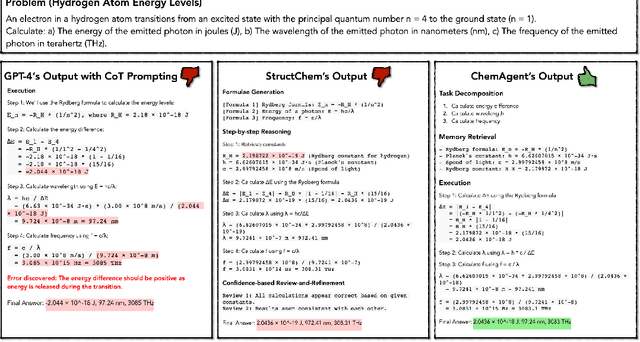
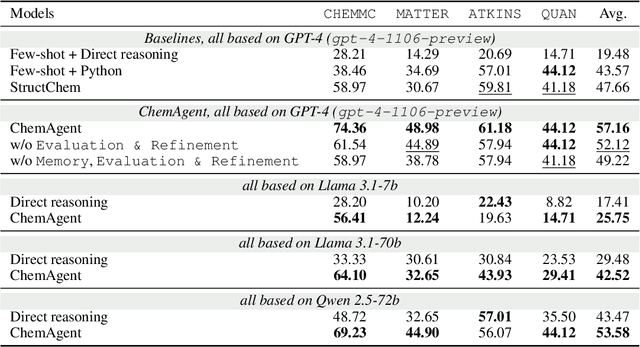
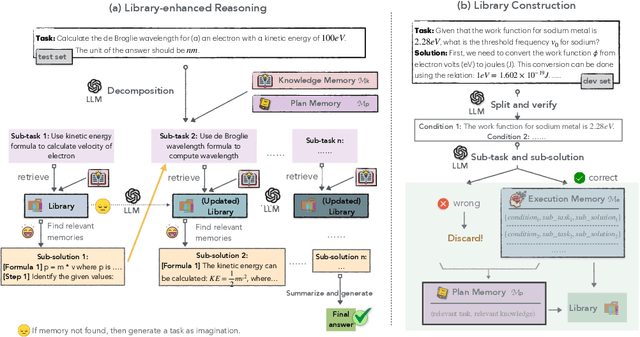

Abstract:Chemical reasoning usually involves complex, multi-step processes that demand precise calculations, where even minor errors can lead to cascading failures. Furthermore, large language models (LLMs) encounter difficulties handling domain-specific formulas, executing reasoning steps accurately, and integrating code effectively when tackling chemical reasoning tasks. To address these challenges, we present ChemAgent, a novel framework designed to improve the performance of LLMs through a dynamic, self-updating library. This library is developed by decomposing chemical tasks into sub-tasks and compiling these sub-tasks into a structured collection that can be referenced for future queries. Then, when presented with a new problem, ChemAgent retrieves and refines pertinent information from the library, which we call memory, facilitating effective task decomposition and the generation of solutions. Our method designs three types of memory and a library-enhanced reasoning component, enabling LLMs to improve over time through experience. Experimental results on four chemical reasoning datasets from SciBench demonstrate that ChemAgent achieves performance gains of up to 46% (GPT-4), significantly outperforming existing methods. Our findings suggest substantial potential for future applications, including tasks such as drug discovery and materials science. Our code can be found at https://github.com/gersteinlab/chemagent
Temperature-Centric Investigation of Speculative Decoding with Knowledge Distillation
Oct 14, 2024Abstract:Speculative decoding stands as a pivotal technique to expedite inference in autoregressive (large) language models. This method employs a smaller draft model to speculate a block of tokens, which the target model then evaluates for acceptance. Despite a wealth of studies aimed at increasing the efficiency of speculative decoding, the influence of generation configurations on the decoding process remains poorly understood, especially concerning decoding temperatures. This paper delves into the effects of decoding temperatures on speculative decoding's efficacy. Beginning with knowledge distillation (KD), we first highlight the challenge of decoding at higher temperatures, and demonstrate KD in a consistent temperature setting could be a remedy. We also investigate the effects of out-of-domain testing sets with out-of-range temperatures. Building upon these findings, we take an initial step to further the speedup for speculative decoding, particularly in a high-temperature generation setting. Our work offers new insights into how generation configurations drastically affect the performance of speculative decoding, and underscores the need for developing methods that focus on diverse decoding configurations. Code is publically available at https://github.com/ozyyshr/TempSpec.
ParallelSpec: Parallel Drafter for Efficient Speculative Decoding
Oct 08, 2024



Abstract:Speculative decoding has proven to be an efficient solution to large language model (LLM) inference, where the small drafter predicts future tokens at a low cost, and the target model is leveraged to verify them in parallel. However, most existing works still draft tokens auto-regressively to maintain sequential dependency in language modeling, which we consider a huge computational burden in speculative decoding. We present ParallelSpec, an alternative to auto-regressive drafting strategies in state-of-the-art speculative decoding approaches. In contrast to auto-regressive drafting in the speculative stage, we train a parallel drafter to serve as an efficient speculative model. ParallelSpec learns to efficiently predict multiple future tokens in parallel using a single model, and it can be integrated into any speculative decoding framework that requires aligning the output distributions of the drafter and the target model with minimal training cost. Experimental results show that ParallelSpec accelerates baseline methods in latency up to 62% on text generation benchmarks from different domains, and it achieves 2.84X overall speedup on the Llama-2-13B model using third-party evaluation criteria.
LEOPARD : A Vision Language Model For Text-Rich Multi-Image Tasks
Oct 02, 2024Abstract:Text-rich images, where text serves as the central visual element guiding the overall understanding, are prevalent in real-world applications, such as presentation slides, scanned documents, and webpage snapshots. Tasks involving multiple text-rich images are especially challenging, as they require not only understanding the content of individual images but reasoning about inter-relationships and logical flows across multiple visual inputs. Despite the importance of these scenarios, current multimodal large language models (MLLMs) struggle to handle such tasks due to two key challenges: (1) the scarcity of high-quality instruction tuning datasets for text-rich multi-image scenarios, and (2) the difficulty in balancing image resolution with visual feature sequence length. To address these challenges, we propose \OurMethod, a MLLM designed specifically for handling vision-language tasks involving multiple text-rich images. First, we curated about one million high-quality multimodal instruction-tuning data, tailored to text-rich, multi-image scenarios. Second, we developed an adaptive high-resolution multi-image encoding module to dynamically optimize the allocation of visual sequence length based on the original aspect ratios and resolutions of the input images. Experiments across a wide range of benchmarks demonstrate our model's superior capabilities in text-rich, multi-image evaluations and competitive performance in general domain evaluations.
Unsupervised Episode Detection for Large-Scale News Events
Aug 09, 2024Abstract:Episodic structures are inherently interpretable and adaptable to evolving large-scale key events. However, state-of-the-art automatic event detection methods overlook event episodes and, therefore, struggle with these crucial characteristics. This paper introduces a novel task, episode detection, aimed at identifying episodes from a news corpus containing key event articles. An episode describes a cohesive cluster of core entities (e.g., "protesters", "police") performing actions at a specific time and location. Furthermore, an episode is a significant part of a larger group of episodes under a particular key event. Automatically detecting episodes is challenging because, unlike key events and atomic actions, we cannot rely on explicit mentions of times and locations to distinguish between episodes or use semantic similarity to merge inconsistent episode co-references. To address these challenges, we introduce EpiMine, an unsupervised episode detection framework that (1) automatically identifies the most salient, key-event-relevant terms and segments, (2) determines candidate episodes in an article based on natural episodic partitions estimated through shifts in discriminative term combinations, and (3) refines and forms final episode clusters using large language model-based reasoning on the candidate episodes. We construct three diverse, real-world event datasets annotated at the episode level. EpiMine outperforms all baselines on these datasets by an average 59.2% increase across all metrics.
Multi-LoRA Composition for Image Generation
Feb 26, 2024
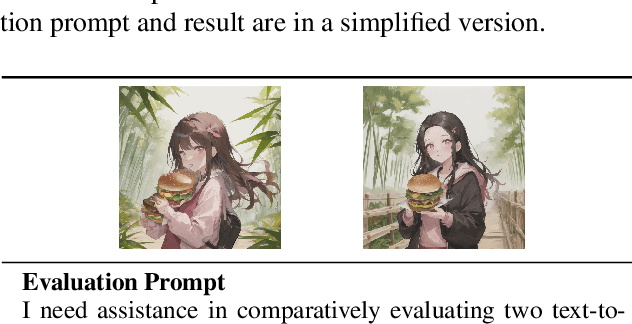
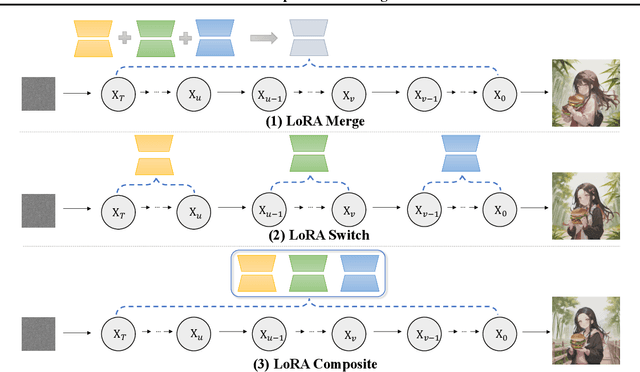
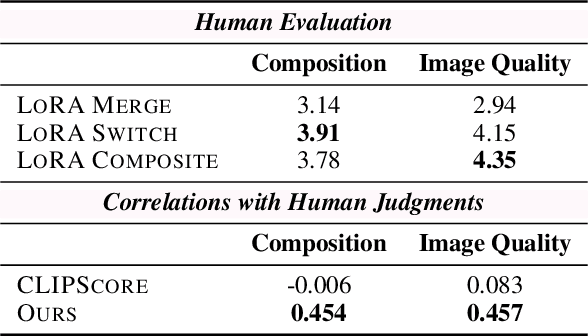
Abstract:Low-Rank Adaptation (LoRA) is extensively utilized in text-to-image models for the accurate rendition of specific elements like distinct characters or unique styles in generated images. Nonetheless, existing methods face challenges in effectively composing multiple LoRAs, especially as the number of LoRAs to be integrated grows, thus hindering the creation of complex imagery. In this paper, we study multi-LoRA composition through a decoding-centric perspective. We present two training-free methods: LoRA Switch, which alternates between different LoRAs at each denoising step, and LoRA Composite, which simultaneously incorporates all LoRAs to guide more cohesive image synthesis. To evaluate the proposed approaches, we establish ComposLoRA, a new comprehensive testbed as part of this research. It features a diverse range of LoRA categories with 480 composition sets. Utilizing an evaluation framework based on GPT-4V, our findings demonstrate a clear improvement in performance with our methods over the prevalent baseline, particularly evident when increasing the number of LoRAs in a composition.
Investigating Data Contamination for Pre-training Language Models
Jan 11, 2024



Abstract:Language models pre-trained on web-scale corpora demonstrate impressive capabilities on diverse downstream tasks. However, there is increasing concern whether such capabilities might arise from evaluation datasets being included in the pre-training corpus -- a phenomenon known as \textit{data contamination} -- in a manner that artificially increases performance. There has been little understanding of how this potential contamination might influence LMs' performance on downstream tasks. In this paper, we explore the impact of data contamination at the pre-training stage by pre-training a series of GPT-2 models \textit{from scratch}. We highlight the effect of both text contamination (\textit{i.e.}\ input text of the evaluation samples) and ground-truth contamination (\textit{i.e.}\ the prompts asked on the input and the desired outputs) from evaluation data. We also investigate the effects of repeating contamination for various downstream tasks. Additionally, we examine the prevailing n-gram-based definitions of contamination within current LLM reports, pinpointing their limitations and inadequacy. Our findings offer new insights into data contamination's effects on language model capabilities and underscore the need for independent, comprehensive contamination assessments in LLM studies.
Structured Chemistry Reasoning with Large Language Models
Nov 16, 2023Abstract:This paper studies the problem of solving complex chemistry problems with large language models (LLMs). Despite the extensive general knowledge in LLMs (such as GPT-4), they struggle with chemistry reasoning that requires faithful grounded reasoning with diverse chemical knowledge and an integrative understanding of chemical interactions. We propose InstructChem, a new structured reasoning approach that substantially boosts the LLMs' chemical reasoning capabilities. InstructChem explicitly decomposes the reasoning into three critical phrases, including chemical formulae generation by LLMs that offers the basis for subsequent grounded reasoning, step-by-step reasoning that makes multi-step derivations with the identified formulae for a preliminary answer, and iterative review-and-refinement that steers LLMs to progressively revise the previous phases for increasing confidence, leading to the final high-confidence answer. We conduct extensive experiments on four different chemistry challenges, including quantum chemistry, quantum mechanics, physical chemistry, and chemistry kinetics. Our approach significantly enhances GPT-4 on chemistry reasoning, yielding an 8% average absolute improvement and a 30% peak improvement. We further use the generated reasoning by GPT-4 to fine-tune smaller LMs (e.g., Vicuna) and observe strong improvement of the smaller LMs. This validates our approach and enables LLMs to generate high-quality reasoning.
 Add to Chrome
Add to Chrome Add to Firefox
Add to Firefox Add to Edge
Add to Edge